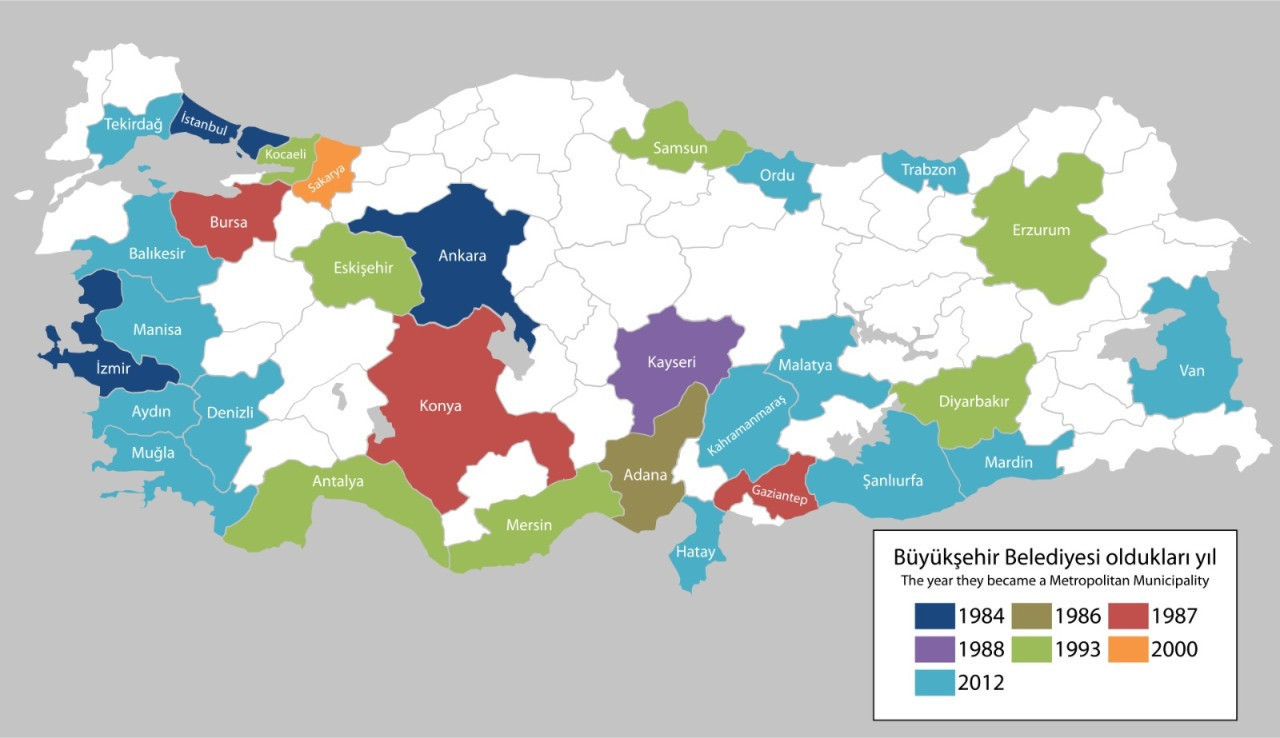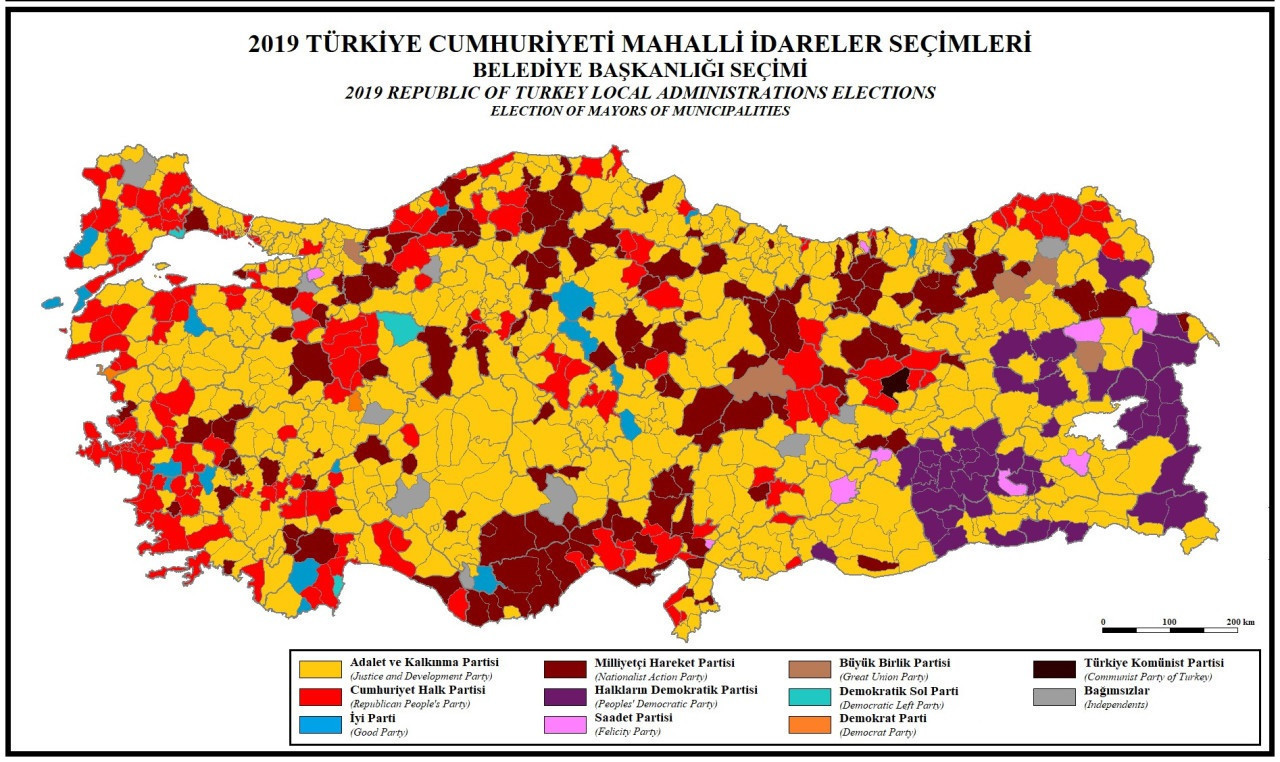Turkey’s local elections: Geographies of metropolitan politics and populist strategy
“Teaching the government a lesson” interpretation for Turkey’s local election results does not explain why voters preferred the CHP when they had a wider range of preferences. Clearly, Akşener and İnce wanted to do to the CHP what the YRP did to the AKP. However, it did not happen. Therefore, it is necessary to analyze the election results not only in terms of the negative, the AKP's defeat, but also in terms of the positive, the victory of the CHP.
The March 31st local elections unfolded unexpectedly, marking the AKP's biggest electoral defeat. A number of reasons have been invoked to explain the results: The economic crisis, the reaction of pensioners, the decline in voter turnout, etc. All of these dynamics certainly played a role. Looking at the results in terms of the AKP's defeat, more or less all explanations lead to the statement that "citizens showed the government a yellow card." However, I think we need to shift our focus in order to interpret the results more comprehensively, because if one outcome of the elections was the AKP's defeat, another was the CHP's victory.
We need to think of these two outcomes separately, especially under conditions where the politics of alliance has collapsed, meaning that the options of voters who feel distant from the government have increased. This is precisely why the metaphor of the "yellow card" seems rather meaningless to me; because it does not explain why voters who want to punish the government (or their party) preferred the CHP when the range of choices has widened. Clearly, İYİ Party leader Meral Akşener and Homeland Party leader Muharrem İnce wanted to do to the CHP what the New Welfare Party (YRP) did to the AKP. However, it did not happen. Therefore, it is necessary to analyze the election results not only in terms of the negative, the AKP's defeat, but also in terms of the positive, the victory of the CHP. And this analysis needs to be done in terms of objective and subjective conditions.
Objective conditions: Metropolitan politics
If we compare the March 31st local elections to a historical antecedent, it should be compared to 1973, when the CHP won local governments for the first time, rather than 1977, when it reached its highest vote share.
If we recall that period briefly, the 60s were the years when slums and the new type of urban poverty that they harbored emerged in metropolitan areas. The rising social opposition hoped that these new urban poor would turn to the left, but this population migrating from the countryside prioritized clinging to the city through nepotism over radical politics, where they had achieved relative prosperity.
The results of the 1968 local and 1969 general elections were the expression of this tendency. However, by 1973, in addition to the crisis of the import substitution system, which was becoming increasingly hard to sustain, two other dynamics, one political and the other social, affected the urbanization process. The violence of March 12 manifested itself in the squatter settlements both in the form of squatter demolitions and in temporarily blocking, albeit temporarily, the nepotistic channels of the organizations (neighborhood beautification associations) that had been suspended by the military government.
Added to this was the fact that a new generation was active in the slums. It was much easier for the second generation, who had not experienced the deprivation of the village like the previous generation, who were born in the city but were not considered urbanites, to become radicalized. It was under these conditions that the CHP unexpectedly took over the administration of all the big provinces, and in the general elections held the same year, it came to power in coalition with the National Salvation Party (MSP), although it could not govern alone.
I think a similar urbanization dynamic is effective today. I have previously discussed this process, which I have called the AKP's urban revolution. To briefly repeat here, under conditions where agricultural subsidies were reduced and the sector was opened to foreign competition during the AKP period, urbanization became urban-oriented both as a quantitative process (migration) and as an organization. Both the number of metropolitan provinces has increased and the area of responsibility of metropolitan provinces has been extended to provincial borders with the metropolitan regulation. This second dynamic, namely the transformation of urban organization, was a dominant process with the transformation of the "urban."

Urbanization is usually understood only as an agglomeration in cities. However, the equivalent of this intensification is the spread of the urban; not only the expansion of the city horizontally, but also the spread of urbanity beyond the concentrated settlement we call the city. When we look at it this way, we need to think of the metropolitan structure not as a concentrated and crowded city, but as a hybridized structure that intensifies its interaction with the outside of the city. When we translate this into the metropolitan structure, we see two political vectors: a vector from the peripheral districts to the metropolitan municipal councils and a second vector that carries the administrative structure in the center to the periphery.

For a long time, the AKP benefited from this first vector - the metropolis hybridizing towards conservatism. This hybridity resulted in the dominance of conservatism in urban politics, allowing the AKP to dominate political mechanisms in urban centers. The geography of urban hegemony for the AKP was established through this vector. In Ankara, for example, the AKP narrowly won the 2014 elections with 45 percent of the vote, while dominating the metropolitan assembly with 72 percent. In the 2019 elections, the CHP won the municipality with 50.93 percent of the vote, but the AKP-MHP bloc still dominated the council with more than 70 percent. And the March 31 elections signal that the balance has now shifted in favor of the second vector.

If we now look back at the electoral map, we see three main geographies of expansion that define the places where the CHP increased its votes and took over from the AKP (and occasionally from the MHP). The first of these, which I will call the "three geographies of metropolitan politics", are the districts in the metropolitan centers, such as Üsküdar and Beyoğlu in Istanbul, and Etimesgut and Keçiören in Ankara. The second is the peripheral districts in the metropolitan area - the whole city - which are the subject of interaction from the center to the periphery. The movement in this second geography is a direct result of the AKP's urban revolution.
The most sensational result of this dynamic was the CHP's majority in metropolitan municipality councils in places with conservative hinterlands such as Ankara, Adana, and Mersin, where it had won in 2019 but was in the minority in metropolitan councils. (I leave out Istanbul, whose second geography is negligible).
The third geography is the provinces that were made metropolitan in 2012. When we look at what we can call the Ankara model, where provinces were made metropolitan with the belief in the domination of Central Anatolian provincial conservatism over cities, it is important to note that what is being discussed in this election as a movement inward from the Aegean coast is the line of metropolitan provinces, Balıkesir, Manisa, Aydın, Denizli, Muğla, which were transferred to the CHP along with their councils. (In other provinces that became metropolitan provinces with the same regulation, other factors are dominant, but I think that this dynamic is also effective there.)
Subjective conditions: Populist strategy
In my last column before the elections, I said: "Even if the deepening economic crisis would affect the election results in favor of the opposition, it would be misleading to interpret this as the continuation of the populist moment or the success of rudderless populist politics."
I have to admit that the election results proved this (pessimistic) conclusion wrong. The strategy of CHP municipalities, which I call "populism per se", seems to have been successful. Social policies aimed at reducing the cost of living for urban dwellers have been very effective in what I described above as the first geography of metropolitan politics, where the economic crisis has exacerbated the cost of living.
Moreover, in the second and third geographies, I think that another -indirect- dynamic derived from the urban populist strategy was effective. In particular, the intense presence of Istanbul Mayor Ekrem İmamoğlu and Ankara Mayor Mansur Yavaş on the national political agenda has not only turned these mayors into national political figures (potential presidential candidates). These mayors have also become visible as mayors. This visibility, especially during the Feb. 6 earthquakes, materialized in the form of actors carrying services beyond their provinces.
In other words, the national recognition of these two mayors should not be thought of as moving to the national scale at a different political level (or in addition to it), but as being recognized on a national scale as local political actors (just like Vedat Dalokay in the 1973-77 period). It was precisely through these qualities that these mayors constructed the idea of a "CHP municipalism" on a national scale, albeit vague and unprogrammed.
This unforeseen dimension of the populist urban political strategy seems to have resonated across Turkey, including in non-metropolitan areas. As I mentioned above, I believe this is an important reason why voters who have distanced themselves from right-wing parties, especially the AKP, are turning to the CHP, which they allegedly "cannot afford to vote for", when they have so many options to vote for.
We also need to think about how objective and subjective conditions interact with each other. We do not have enough data yet; in fact, there is almost no significant research on the second and third geographies of metropolitan politics. However, we have good reason to believe that the transformation of these geographies in the last decade has not been limited to access to services and infrastructure integration.
These geographies are apparently increasingly imagined by their inhabitants as part of the metropolis, and the political processes of the metropolis (in line with the second vector I have described above) are becoming more active in these geographies by expanding from access to services to demands for participation, transparency, and social justice.

